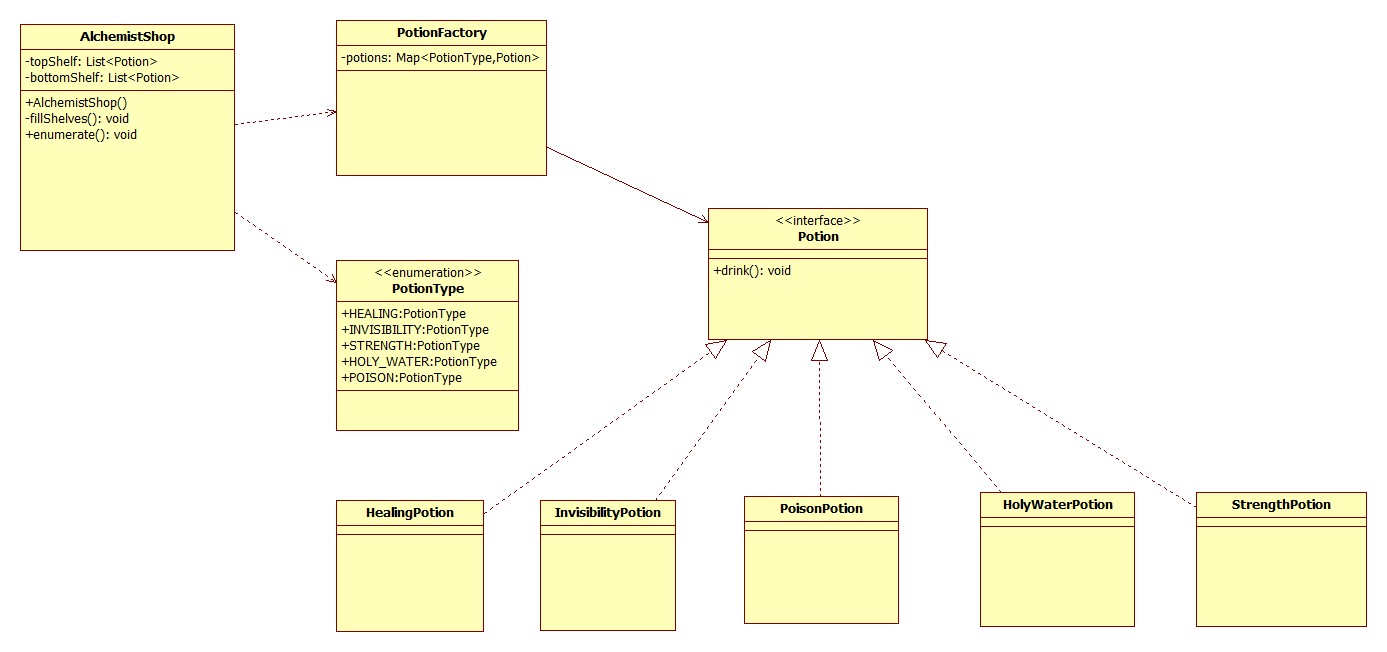//
//
// Generated by StarUML(tm) Java Add-In
//
// @ Project : Untitled
// @ File Name : Potion.java
// @ Date : 2016/8/23
// @ Author :
//
//
/*
* 药水 接口
*/
public interface Potion {
public void drink();
}
//
//
// Generated by StarUML(tm) Java Add-In
//
// @ Project : Untitled
// @ File Name : HealingPotion.java
// @ Date : 2016/8/23
// @ Author :
//
//
public class HealingPotion implements Potion {
public void drink() {
System.out.println("You feel healed. (Potion="
+ System.identityHashCode(this) + ")");
}
}
//
//
// Generated by StarUML(tm) Java Add-In
//
// @ Project : Untitled
// @ File Name : HolyWaterPotion.java
// @ Date : 2016/8/23
// @ Author :
//
//
public class HolyWaterPotion implements Potion {
public void drink() {
System.out.println("You feel blessed. (Potion="
+ System.identityHashCode(this) + ")");
}
}
//
//
// Generated by StarUML(tm) Java Add-In
//
// @ Project : Untitled
// @ File Name : InvisibilityPotion.java
// @ Date : 2016/8/23
// @ Author :
//
//
public class InvisibilityPotion implements Potion {
public void drink() {
System.out.println("You become invisible. (Potion="
+ System.identityHashCode(this) + ")");
}
}
//
//
// Generated by StarUML(tm) Java Add-In
//
// @ Project : Untitled
// @ File Name : PoisonPotion.java
// @ Date : 2016/8/23
// @ Author :
//
//
public class PoisonPotion implements Potion {
public void drink() {
System.out.println("Urgh!This is poisonous.(Potion=" + System.identityHashCode(this) + ")");
}
}
//
//
// Generated by StarUML(tm) Java Add-In
//
// @ Project : Untitled
// @ File Name : StrengthPotion.java
// @ Date : 2016/8/23
// @ Author :
//
//
public class StrengthPotion implements Potion {
public void drink() {
System.out.println("You feel strong. (Potion="
+ System.identityHashCode(this) + ")");
}
}
/*
* 枚举药水
*/
public enum PotionType {
HEALING,//疗伤药水
INVISIBILITY,//隐形药水
STRENGTH,//力量药水
HOLY_WATER,//神圣的药水
POISON; //有毒的药水
}
//
//
// Generated by StarUML(tm) Java Add-In
//
// @ Project : Untitled
// @ File Name : PotionFactory.java
// @ Date : 2016/8/23
// @ Author :
//
//
public class PotionFactory {
private final Map<PotionType,Potion> potions;
public PotionFactory(){
potions = new EnumMap<>(PotionType.class);
}
Potion createPotion(PotionType type)
{
Potion potion = potions.get(type);
if(potion == null)
{
switch(type)
{
case HEALING:
potion = new HealingPotion();
potions.put(type,potion);
break;
case HOLY_WATER:
potion = new HolyWaterPotion();
potions.put(type,potion);
break;
case INVISIBILITY:
potion = new InvisibilityPotion();
potions.put(type,potion);
break;
case POISON:
potion = new PoisonPotion();
potions.put(type,potion);
break;
case STRENGTH:
potion = new StrengthPotion();
potions.put(type,potion);
break;
default:
break;
}
}
return potion;
}
}
//
//
// Generated by StarUML(tm) Java Add-In
//
// @ Project : Untitled
// @ File Name : AlchemistShop.java
// @ Date : 2016/8/23
// @ Author :
//
//
/*
* 炼金术士商店
* AlchemistShop 持有药水在它的药架上
* 它使用药水工厂去提供一些药水.
*/
public class AlchemistShop {
private List<Potion> topShelf;
private List<Potion> bottomShelf;
public AlchemistShop() {
topShelf = new ArrayList<>();
bottomShelf = new ArrayList<>();
fillShelves();
}
private void fillShelves() {
PotionFactory factory = new PotionFactory();
topShelf.add(factory.createPotion(PotionType.INVISIBILITY));
topShelf.add(factory.createPotion(PotionType.INVISIBILITY));
topShelf.add(factory.createPotion(PotionType.STRENGTH));
topShelf.add(factory.createPotion(PotionType.HEALING));
topShelf.add(factory.createPotion(PotionType.INVISIBILITY));
topShelf.add(factory.createPotion(PotionType.STRENGTH));
topShelf.add(factory.createPotion(PotionType.HEALING));
topShelf.add(factory.createPotion(PotionType.HEALING));
bottomShelf.add(factory.createPotion(PotionType.POISON));
bottomShelf.add(factory.createPotion(PotionType.POISON));
bottomShelf.add(factory.createPotion(PotionType.POISON));
bottomShelf.add(factory.createPotion(PotionType.HOLY_WATER));
bottomShelf.add(factory.createPotion(PotionType.HOLY_WATER));
}
public void enumerate() {
System.out.println("Enumerating top shelf potions\n");
for (Potion p : topShelf) {
p.drink();
}
System.out.println("\nEnumerating bottom shelf potions\n");
for (Potion p : bottomShelf) {
p.drink();
}
}
}
/*
* 享元模式是有用的,当程序需要大量的对象。它提供了手段,减少资源使用通过共享对象实例。
* 在这个例子中AlchemistShop大量药剂的货架上。
* 填充货架AlchemistShop使用PotionFactory(代表了轻量级选手在这个例子)。
* 内部PotionFactory药水的地图,懒加载地创建新的资源。
*/
public class App {
public static void main(String[] args) {
AlchemistShop as = new AlchemistShop();
as.enumerate();
}
}
//
// Enumerating top shelf potions
//
// You become invisible. (Potion=916483725)
// You become invisible. (Potion=916483725)
// You feel strong. (Potion=1589249791)
// You feel healed. (Potion=119635951)
// You become invisible. (Potion=916483725)
// You feel strong. (Potion=1589249791)
// You feel healed. (Potion=119635951)
// You feel healed. (Potion=119635951)
//
// Enumerating bottom shelf potions
//
// Urgh!This is poisonous.(Potion=676734865)
// Urgh!This is poisonous.(Potion=676734865)
// Urgh!This is poisonous.(Potion=676734865)
// You feel blessed. (Potion=809481543)
// You feel blessed. (Potion=809481543)
java设计模式进阶_flyweight
最新推荐文章于 2016-09-05 15:09:42 发布






















 5166
5166











 被折叠的 条评论
为什么被折叠?
被折叠的 条评论
为什么被折叠?








